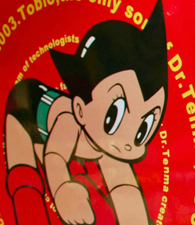Osamu Tezuka has been called the “god of comics” in Japan. After writing his first comic strip in third grade, Tezuka published his first professional manga while studying at medical school. His innovations to the field of Japanese comics and animation are evident through the 700 works he produced, which include more than 150,000 pages of manga.
Osamu Tezuka’s Early Days
Osamu Tezuka was born on November 3, 1928, in Toyonaka, Osaka, Japan, the first child of Yutaka and Fumiko Tezuka. Tezuka was small for his age; constantly bullied in school, he sought solace in the stories his parents shared with him—Tezuka’s mother loved storytelling and his father was an avid comic book fan who showed movies at home. Tezuka got his start producing manga (elaborate narrative comics popular in Japan) in third grade when he created “Bin Bin Namachan,” an illustrated story about a bald boy. The tale was based on Tezuka’s own experience with a bad haircut.
Throughout his young adulthood, Tezuka continued to practice drawing and maintained his interest in comics. Despite his artistic inclinations, Tezuka enrolled in college as a medical student at age 18. But his studies did not interfere with his love of illustration: while in college, Tezuka made his official manga debut with a newspaper comic strip called “Ma-chan’s Diary.” This breakthrough helped him sell paperback copies of his longer narratives, which quickly became popular.
Sources in this Story
- IMDb: Biography for Osamu Tezuka
- Osamu Tezuka: Biography
- Japan Zone: Tezuka Osamu
- Tezuka in English: For New Readers
- Animation World Magazine: The Osamu Tezuka Manga Museum: A Cultural Monument
Tezuka’s Notable Accomplishments
Tezuka eventually completed his physician’s degree in 1958, but it was overshadowed by his early success with comics. As his storytelling and illustrating evolved, Tezuka developed many of the features now associated with the artistic style of manga and anime (Japanese animated films). For example, Tezuka created characters with large, alluring eyes, which have become iconic for manga and anime characters. His manga “Princess Knight” introduced the now-standard plot element of a girl dressed as a boy, an idea probably inspired by the Takarazuka Revue, an all-women’s theatrical group that performed in his childhood town and has traditionally included women taking on male roles.
After his first publications, Tezuka became an increasingly revered illustrator and storyteller, producing manga that came to define the standards of the industry including “Jungle Emperor Leo” (aka “Kimba the White Lion”) and the series “Tetsuwan Atomu,” or “Astro Boy,” both of which became popular animated series as well.
From his beginnings as a child illustrator in 1937 to his death in 1989, Tezuka produced more than 700 comics. Some of his most popular works included “Metropolis,” “New Treasure Island,” “Black Jack” and “Buddha.” Although Tezuka was involved in the creation of hundreds of manga and anime films and cartoons, his role often varied from project to project. For a list of Tezuka’s contributions to the field, visit the Anime News Network Web site, which also provides links to news articles and reviews about his work.
The Man and his Work
- “Buddha, Volume 1: Kapilavastu”
- “Astro Boy: Volumes 1 & 2”
- “Metropolis”
- “Black Jack: Volume 1”
- “Dororo: Volume 1”
- “Phoenix: Dawn”
The Rest of the Story
Osamu Tezuka wrote over 150,000 pages of manga in his lifetime, many of which contained themes of “progress, technology, environmentalism, tolerance and reincarnation and his messages of hope and calls for greater social responsibility,” according to Tezuka in English, a Web site dedicated to the artist’s life and work. The site helps readers new to Tezuka’s oeuvre determine what narratives to read first, as the breadth of Tezuka’s stories can be overwhelming. In addition to a narrated documentary on Tezuka’s life, the site also shows fans where to look for information on upcoming products, films, cartoons and manga series based on the characters Tezuka created. Although Tezuka died of stomach cancer in 1989 at age 60, his work continues to win awards and spawn new programs, series and exhibitions.
The Osamu Tezuka Manga Museum located in Takarazuka honors Osamu Tezuka’s impact on Japanese culture. An article about the museum explains Tezuka’s legacy as an animator: “In 1964, Tezuka met [Walt] Disney at the New York World’s Fair, and although the two creators have often been paralleled, Tezuka remained more low keyed and close to his role as a master cartoonist than his counterpart. Yes, Tezuka created an animation empire, with thousands of memorable characters, yet he managed to remain independent, a free-spirited businessman—a rare achievement.”
This article was originally written by Isabel Cowles; it was updated October 29, 2017.











